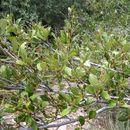Comprehensive Description
provided by North American Flora
Cercocarpus montanus Raf. Atl. Jour. 146. 1832
Cercocarpus f other gilloides Torr. Ann. Lye. N. Y. 2: 198. 1827. Not C. f other gilloides H. B. K.
1823. Cercocarpus parvifolius Nutt.; H. & A. Bot. Beech. Voy. 337. 1838. Cercocarpus parvifolius hirsutissimus C. K. Schneid. Handb. Laubh. 1: 532. 1905. Cercocarpus parvifolius typicus C. K. Schneid. Mitt. Deuts. Dendr. Ges. 14: 126. 1905.
Shrub 1-2 m. (rarely 3 m.) high, with grayish, fissured, persistent bark; branches sparingly pilose when young; petioles 3-6 mm. long, pilose or silky; leaf-blades broadly obovate, 2-5 cm. 421
long, 1.5-2.5 cm. wide, coarsely serrate with ovate teeth, neither very thick nor rugose, rounded at the apex, acute at the base, green and loosely pilose above when young, more silky in age, pale and finely tomentose beneath; lateral veins 4-6 on each side, not very prominent beneath; flowers solitary or two or three together in the axils of the leaves, pedicelled; tube of the hypanthium about 1 cm. long, pilose; limb campanulate or somewhat turbinate, pilose without, glabrous within, together with the sepals 6-7 mm. wide; sepals broadly triangular, acute; achenes about 10 mm. long, appressed silky-hirsute; style in fruit 6-8 cm. long.
Type locality: Rocky Mountains [Colorado],
Distribution: Hills and mountain-sides, from South Dakota to western Kansas, New Mexico, Utah, and Montana.
- bibliographic citation
- Per Axel Rydberg. 1913. ROSACEAE (pars). North American flora. vol 22(5). New York Botanical Garden, New York, NY
Comprehensive Description
provided by North American Flora
Cercocarpus flabellifolius Rydberg, sp. no v
A low shrub with gray, smooth, flaky bark; branches short, sparingly strigose when young, soon glabrous; petioles 1-3 mm. long, strigose; leaf-blades obovate-flabelliform, 1-2 cm. long and nearly as broad, coarsely dentate above the middle, appressed silky-strigose on both sides, dark-green above, pale beneath, the teeth usually broader than long; lateral veins 3-5 on each side; flowers 1 or 2 in the axils, subsessile or with very short pedicels; tube of the hypanthium silky-strigose; limb campanulate, silky-strigose without, puberulent within, together with the sepals 5 mm. wide; sepals triangular, acute; anthers somewhat hairy; achenes about 8 mm. long; style in fruit 6-7 cm. long.
Type collected on hills near Glenwood, Utah, at an altitude of 2100 m., May 29, 1875, L. F. Ward (herb. N. Y. Bot. Gard.).
Distribution: Central and southern Utah and northeastern New Mexico.
- bibliographic citation
- Per Axel Rydberg. 1913. ROSACEAE (pars). North American flora. vol 22(5). New York Botanical Garden, New York, NY

